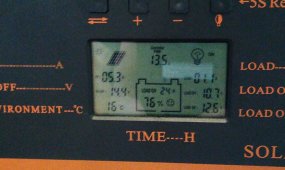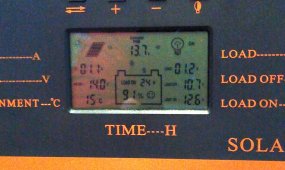I have six 100 watt solar panels on the roof of my off-grid cabin. I have been using lead-acid batteries with an 80A PWM charge controller. Charge voltage had been set at 13.8V. I want to swap out the lead-acid batteries for a 300AH LiFePO4 battery. I reset the charge voltage to 14.4V. I have a 12V timer that turns on a 600W sine wave inverter which powers four web cams and a router for five minutes every hour. That 600W inverter was OK being fed 13.8V but it doesn't like 14.4V or even 14.2V. It'll work with 14V but I suspect I won't get best LiFePO4 charging efficiency using 14V instead of 14.4V or even 14.6V. What's the solution? The 600W inverter, cameras, & router are on a separate 12V line. Is there some kind of step down voltage regulator I can buy? Is there an inverter that isn't so fussy about being fed 14.4V? Thanks!
You are using an out of date browser. It may not display this or other websites correctly.
You should upgrade or use an alternative browser.
You should upgrade or use an alternative browser.
Inverter Over-voltage Alarm
- Thread starter Adarondax
- Start date
BentleyJ
Solar Wizard
14V is 3.5V per cell which will give you 95+ % charge.
As long as all the cells reach 3.425V with sufficient absorb time, the battery will be charged.
As long as all the cells reach 3.425V with sufficient absorb time, the battery will be charged.
GTK. Thanks. Because I don't get full-day sun, faster charging at 14.6V may still offer an advantage.14V is 3.5V per cell which will give you 95+ % charge.
As long as all the cells reach 3.425V with sufficient absorb time, the battery will be charged.
efficientPV
Solar Addict
- Joined
- Sep 24, 2019
- Messages
- 1,355
You could put a diode in series with the power and that will drop the voltage a consistent 0.7 to 1V. Amps times that voltage will be the heat that has to be dissipated. Security cameras shouldn't be that much power. A switch could short it out when the sun isn't shining, or you need more power. Use several diodes in parallel to get the current and distribute heat evenly. A 40A diode won't handle 40A. Why are you even running these with an inverter?
I have this 12V timer...You could put a diode in series with the power and that will drop the voltage a consistent 0.7 to 1V. Amps times that voltage will be the heat that has to be dissipated. Security cameras shouldn't be that much power. A switch could short it out when the sun isn't shining, or you need more power. Use several diodes in parallel to get the current and distribute heat evenly. A 40A diode won't handle 40A. Why are you even running these with an inverter?
which turns on this inverter for 5 minutes of every daylight hour...
The inverter powers four of these cameras...
and this WiFi router...
The router makes a WiFi connection to a generous neighbor about 1 mile across a lake.
How would I set this up w/o an inverter?
Last edited:
I don't know enough about diodes and voltage drops to attempt that. I'm thinking about buying something like this to do that job.I have this 12V timer...
which turns on the inverter for 5 minutes of every daylight hour. The inverter powers four of these cameras...
and this WiFi router...
The router makes a WiFi connection to a generous neighbor about 1 mile across a lake.
How would I set this up w/o an inverter?
efficientPV
Solar Addict
- Joined
- Sep 24, 2019
- Messages
- 1,355
There can be issues hen the voltages are too close together. Do at least a 1.5v drop. Diode would be more reliable.
Texas-Mark
Solar Addict
- Joined
- Aug 4, 2021
- Messages
- 1,284
faster charging at 14.6V may still offer an advantage.
???
Unless your battery cells are well balanced, you will most likely trip the BMS even under to 14.4. That can cause the inverter to see a higher voltage from the charger and go into over voltage. 14V charging will be fine for Lifepo4.
efficientPV
Solar Addict
- Joined
- Sep 24, 2019
- Messages
- 1,355
We are only taking your word for all this. Any inverter that shuts down at 14.4V has not had its limit set properly. I have an inverter that goes into over voltage fault often If I leave it on. It runs my fridge and when the fridge turns off the charge controller slowly climbs to over 15.5V. It doesn't bother me that much because normally the inverter only runs when the fridge is on. Sometimes I turn i on to do some work and a 175W soldering gun will cause the voltage to climb when trigger is released. I've tried this with three other MPPT controllers and they all do the same thing as it is a common industry software practice. My battery is small, always fully charged and easy to overload. I don't like PWM controllers on lithium batteries as that can cause issues. I'm wondering if the voltage monitor is seeing spikes from the PWM.
He maybe accounting for some voltage drop between the SCC and the battery terminals.???
Unless your battery cells are well balanced, you will most likely trip the BMS even under to 14.4. That can cause the inverter to see a higher voltage from the charger and go into over voltage. 14V charging will be fine for Lifepo4.
Just a wild guess on my part, as any system should take full solar output at say 14v if the SOC is low, dialing up the SCC bulk voltages shouldn’t allow more solar output.
But I do agree that if the battery terminals are seeing 14.6v that’s too high.
This is why I enjoy Victron smart SCC and smart shunt, they are paired up so the SCC knows the battery terminal voltage and dials it right in.
I'm going by how the charge controller is set. I haven't checked the line voltage with a meter yet. Would the voltage rise if the BMS disconnects the battery from the panels?We are only taking your word for all this. Any inverter that shuts down at 14.4V has not had its limit set properly. I have an inverter that goes into over voltage fault often If I leave it on. It runs my fridge and when the fridge turns off the charge controller slowly climbs to over 15.5V. It doesn't bother me that much because normally the inverter only runs when the fridge is on. Sometimes I turn i on to do some work and a 175W soldering gun will cause the voltage to climb when trigger is released. I've tried this with three other MPPT controllers and they all do the same thing as it is a common industry software practice. My battery is small, always fully charged and easy to overload. I don't like PWM controllers on lithium batteries as that can cause issues. I'm wondering if the voltage monitor is seeing spikes from the PWM.
Attachments
efficientPV
Solar Addict
- Joined
- Sep 24, 2019
- Messages
- 1,355
PWM connects panels right to the battery. If there is no battery to load the panel, the voltage can go to almost open circuit voltage. I had one PWM controller and the voltage on the display had no relation to what the battery read. I have a big capacitor on output of CC just in case battery gets disconnected ad absorb any spikes. I had one and just put it on. Can't guarantee it actually does anything.
Texas-Mark
Solar Addict
- Joined
- Aug 4, 2021
- Messages
- 1,284
Would the voltage rise if the BMS disconnects the battery from the panels?
More than likely yes. Perhaps just briefly, but long enough to cause an over-voltage condition to whatever is connected to it.
mikefitz
Solar Wizard
- Joined
- May 28, 2020
- Messages
- 2,979
I suspect your PWM controller is producing a higher voltage than you expect. Most of this style of controller perform badly. Changing to a quality MPPT controller would offer far better operation.
Charging lithium at 14.0 will not extend the charge time significantly compared to 14.4 .
Charging lithium at 14.0 will not extend the charge time significantly compared to 14.4 .
Similar threads
- Replies
- 2
- Views
- 456
- Replies
- 3
- Views
- 156
- Replies
- 5
- Views
- 667




